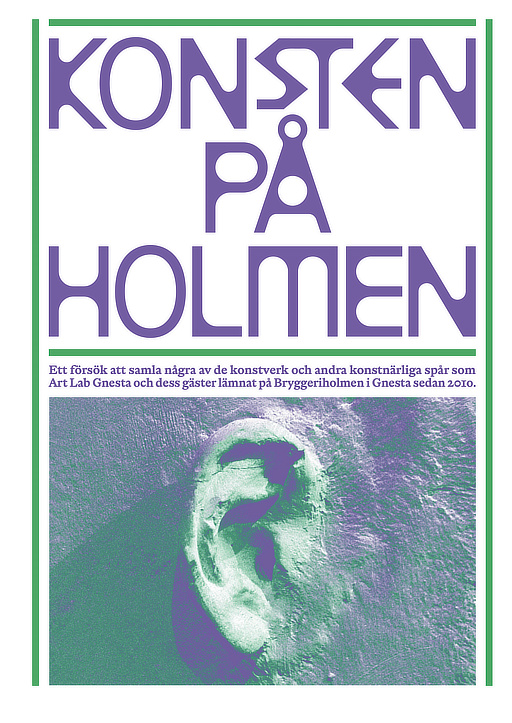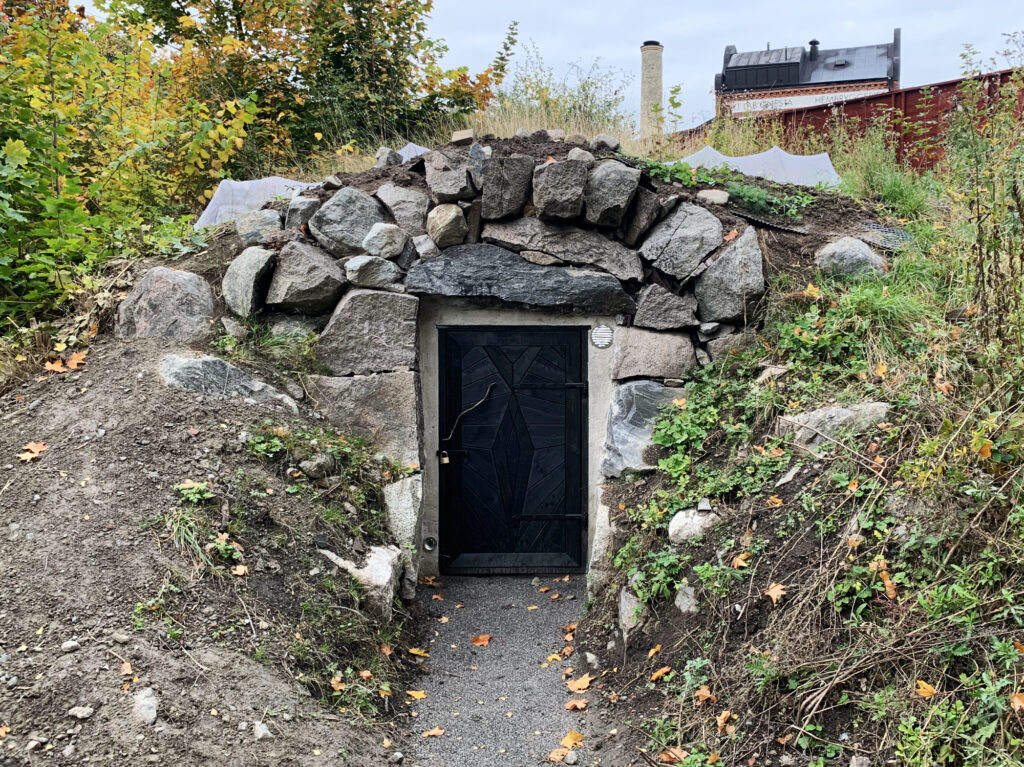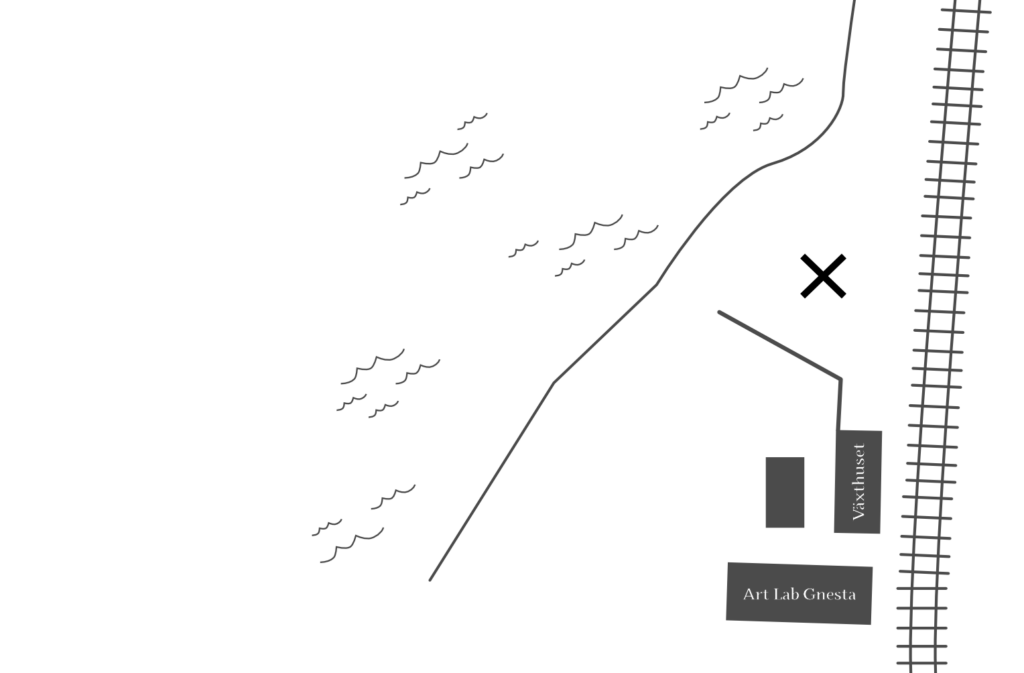Permanent artworks
 “Konsten på holmen“(Art on the Island) is a printed publication, designed by Lars Høie, produced in the winter of 2024 and can be picked up at Art Lab Gnesta.
“Konsten på holmen“(Art on the Island) is a printed publication, designed by Lars Høie, produced in the winter of 2024 and can be picked up at Art Lab Gnesta.
An attempt to compile some of the artworks and other artistic traces that Art Lab Gnesta and its guests have left on Bryggeriholmen in Gnesta since 2010.
It is also available as a pdf:
Donwload Konsten på holmen (only in Swedish)
In the Brewery House:
- The ear (2021) Rädda jorden-klubben (Save the Earth Club)
- Biblioteca Pangolina (2022–)
- Out of the sea, you have come (2024) by Saskia Gullstrand
- Granbarkborretapeten (2021)
- Bat houses (2024)
- Rikta blicken nedåt (2020) by Squid Squad and Åsa Norman
In the greenhouse:
- Gnesta Zahkrafa (2018)
- Teknofossil (2020) by Sara Söderberg
- Llac (2022) by Cara Tolmie and Julia Giertz
- Tracing water life levels (2022) by Sara Ekholm Eriksson
- High Tide Fine Line
At the bryggeriholmen:
- Brf Bryggeriholmen 2 (2015)
- The Cellar (2022) by Mirko Nikolic and Marika Troili
- Målarmusslans vänner (Friends of the thick-shelled river mussel) (2023)
- The Saqba tomato (2016–)
Technofossil (2020) by Sara Söderberg
The installation Technofossil (2020) by Sara Söderberg moves from limestone to cement and back. Now it has been permanently installed in the entrance to the greenhouse behind Art Lab Gnesta. The work connects us with the 450-million-year-old fossils in the rock, which are now irreversibly dissolved and transformed through the concrete into homogeneous buildings in the modern world.
The work was part of the exhibition Memory, material, mineral which was shown at Art Lab Gnesta 19/3-12/6 2022.
The Cellar, 2022
Mirko Nikolic & Marika Troili
Now Bryggeriholmen’s underground cellar is being put back into shared use. It was probably built in the 1860s from blasted stone after the railway was built right next to it. After a restoration, the artists Mirko Nikolic and Marika Troili have been invited to work on the interior design, and on top grown potatoes and cabbage. Inside the cellar they installed a shelving system made of pine from a nearby forest, charred according to an ancient Japanese technique to protect it from moisture and decay.
With a shared key for everyone who inhabits Bryggeriholmen, it becomes a collective pantry and an exercise in sharing. There is also a trading shelf here, which opens up during special events. Here the public is welcome to bring something that would be suitable for storage in an root cellar and exchange it for something else on the shelf. Swap lingonberry jam for sauerkraut, sauerkraut for potatoes, potatoes for rhubarb juice, rhubarb juice for pickles, pickles for plum marmalade, plum marmalade for pickled carrot, pickled carrot for…
As the artists themselves write: “Root cellaring may be one of a multitude of everyday portals needed to break with violent pasts and reweave our world.”

The Cellar, 2022 by Mirko Nikolic & Marika Troili

Map: The cellar at Bryggeriholmen marked with an X.
High Tide Fine Line – permanent artworks by the new watering hole of Art Lab Gnesta
During 2022 Art Lab Gnesta hosted artistic residencies with Stockholm based artists Cara Tolmie and Julia Giertz, Sara Ekholm Eriksson and Emmeli Person, invited by curator Bronwyn Bailey-Charteris. During the residencies the artists each developed a commission that responded to the new waterbody, the pond, that now lives in the greenhouse of Art Lab Gnesta. These sophisticated and nuanced artists each approached the new body of water as a site to consider ‘ingestion’, ‘embodiment’ and how art can ‘take residence’ in the waters. These artists each found unique ways to enact a moment of ‘high tide’ where they sense the body of water in Art Lab Gnesta as part of the whole, that is, the worlds water.
Llac, 2022
Aluminium and sound,12 min
Cara Tolmie and Julia Giertz
Drawing on their shared interests in sound, sculpture and the body, artists Cara Tolmie and Julia Giertz collaborated to make a suspended, sonic sculpture entitled Llac. The curved metal sculpture hangs above the pond, emitting a sonic playlist of bodily noises that connect with the water inside ourselves. The sonic sculpture is a piece that reverberates, sings and contracts. Llac is a permanent sculpture that uses the sonic as a way to reverberate between watery beings.
Tracing water life levels, 2022
Soapstone, engraving, acrylic, lacquer, rainwater.
Sara Ekholm Eriksson
Together with natural scientist Emma Wahlberg, artist Sara Ekholm Eriksson created a permanent work for the new waterbody. Sara worked with Art Lab Gnesta in the design of the pond and has engraved directly onto the stone stairs that lead into the pond. The engravings are a set of inscriptions of the markings made by local insects from Gnesta. These markings by the artist, entitled Tracing water life levels, remind visitors of the other bodies, both non- human and human, that share water as the foundation of all life.
Hold that thought
Catch feelings
Keep that secret safe, 2022
residency and planned performance
Emmeli Person
During her residency with Art Lab Gnesta, artist Emmeli Person spent time collecting an archive of the other bodies of water that are in close proximity with the new pond. Person carefully constructed a performative costume, made from local bulrushes and foraged sticks to honour the water as an archive and memory holder. In her residency, the artist sought to work with performance and musicality as a way to celebrate the new waterbody as a place which both stores and stories through water.
Produced with the support of Swedish Arts Council
![]()